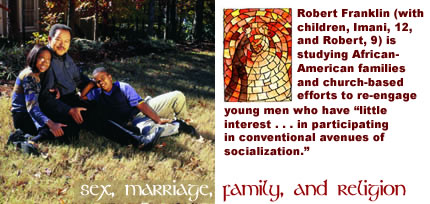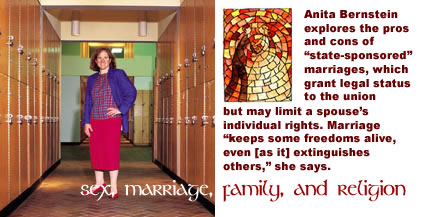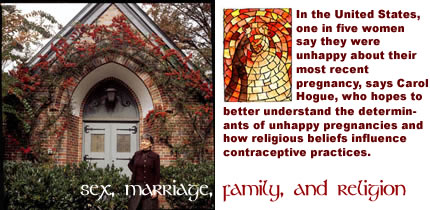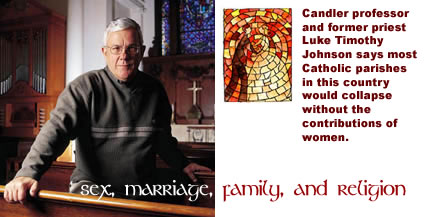When
Jews, Christians, or Muslims choose spouses
outside their faiths, the resulting marriages may
provoke family and societal tensions, says Charles
Howard Candler Professor of Law Abdullahi Ahmed
An-Na’im. These marriages, he says, serve as
a “useful prism for understanding relationships
among people and communities of different religious
traditions.”
One
such couple, Sameera Khan, a Muslim, and Manesh
Patel, a Hindu, didn’t let their different
faiths deter them.
“Manesh
and I met on a trek. When we decided to marry, religion
wasn’t an issue between us,” says Khan.
Nor was the fact that in Bombay, where they live,
most marriages are still arranged.
As
wedding plans evolved, however, the couple realized
their families’ differing beliefs and traditions
would have to be addressed.
“We
knew we had to keep it the way we wanted and also
placate each side,” Patel says.
“I’m
constantly trying to negotiate these things within
myself,” Khan adds. “If it pleases my
in-laws, I’ll do certain things. It’s
not for the gods I’m doing this, it’s
for the human beings.”
An-Na’im
is studying the ramifications of religiously mixed
marriages in Bombay, India; Istanbul, Turkey; and
Dakar, Senegal, as a senior fellow in Emory’s
Center for the Interdisciplinary Study of Religion
(CISR).
Created
in the fall of 2000 with a five-year, $3.2 million
grant from the Pew Charitable Trusts, the CISR is
meant to encourage research and education on religious
themes. Its first two-year project, “Sex, Marriage,
and Family and the Religions of the Book,”
has prompted research on family law in Islamic societies,
the depiction of women in the Hebrew Bible, same-sex
unions and the Christian church, a historical view
of illegitimacy, the impact of religious beliefs
on contraceptive practices, and the perils of a
celibate clergy, among other topics.
“We
are summoning our resources and getting the religious
community in all its diversity to deal with the
hardest questions modern society is asking: What
goes on in the womb and before? Where do you define
the edges of marriage and non-marriage? In what
forum can sexuality best be expressed and disciplined?”
says Jonas Robitscher Professor of Law and Ethics
John Witte Jr., director of the CISR.
Under
the auspices of the center, eighteen fellows from
public health, law, theology, English, women’s
studies, and several other disciplines are examining
how scripture and the collective wisdom of religious
traditions–largely Christianity, Judaism, and
Islam–can be applied to contemporary social
problems.
Joining
colleagues in the “ongoing conversation about
the nature of a just society and of a good person,”
has been an engaging experience, says CISR senior
fellow Robert M. Franklin. “These ancient categories
have animated intellectual and grassroots discourse
for centuries.”
Franklin,
recently named a presidential distinguished professor
of social ethics at Candler, has focused his research
on the future of African-American marriages and
families, particularly the growing absence of young
black men as husbands and fathers.
“This
phenomenon could compromise efforts to increase
black marriage rates and provide caring parents
for all of our children,” Franklin says. “There
are some innovative congregation-based efforts,
both Christian and Muslim, to reverse this exodus
of men.”
In addition to fellows’ research projects,
the center also sponsored six lectures on such controversial
issues as cloning, same-sex unions, and celibacy
in the priesthood that reached more than 1,200 members
of the public–one of the mandates of the grant.
“It’s
our hope that centers such as the one at Emory will
do work that enables not just campus communities
but the public at large to see how religion works
in society,” says Diane Winston, program director
for religion at Pew.
The sex, marriage, and family project culminates
with an international conference March 27-29 at
Emory involving more than eighty scholars and public
intellectuals who will lead panels on such topics
as, “I Do, I Don’t: The Cases for and
Against Marriage,” “Suffer the Children?
Contraception, Abortion, and Reproductive Stewardship,”
and “Living Alone: The Vocations of Singleness
and Celibacy.” The concluding keynote, “Sex,
Marriage, and Family: The Challenges of the New
Century,” will be given Saturday, March 29,
at 7:30 p.m. by Colgate University President Rebecca
S. Chopp, former Emory provost.
Twenty-nine books have been generated through the
CISR–seventeen written by the fellows, such
as Michael Broyde’s Marriage, Divorce, and
the Abandoned Wife in Jewish Law and Don Browning’s
Marriage and Modernization, and a dozen anthologies
from the public forums and conference.
The
church can no longer shy away from controversial
matters but must weigh in, says Witte, adding its
voice to the public discourse and creatively adapting
and applying the ancient wisdom of scripture, whether
it be to public policy debates or private decisions.
Religion
and sex may seem strange bedfellows, he admits,
but their entanglement–and the importance of
one to the other–cannot be dismissed.
“Sex,”
Witte says, “can be the most sublime of human
interactions and the most scarring of human violations.”
The
following three profiles represent a sampling of
the research being conducted by CISR fellows.
For more information about the center and the conference
“Sex, Marriage, & the Religions of the
Book: Modern Problems, Enduring Solutions”,
go to www.law.emory.edu/cisr.

I.
The Cases For and Against Legal Marriages
Marriage
has five dimensions, according to the Council on
Families in America–natural, religious, economic,
social, and legal. Anita Bernstein, Sam Nunn Professor
of Law, is interested in the fifth: marriage as
a legal concept, from which other “privileges
and disabilities ensue.”
When
men and women marry, they acquire a new status in
the eyes of the state. From that point on, the law
will treat them differently with respect to contracts,
crimes, property holdings, and finances.
“It
is peculiar for contemporary Americans to hold a
status-label that limits their freedom,” says
Bernstein, a senior fellow in the CISR. “Over
time, American law has abandoned or weakened most
status-labels, such as slavery and race. What is
the reason for the status of legal marriage?”
Bernstein
explores this thesis in For and Against Marriage:
Strategies to Critique, Defend, Reform, and Appraise
a Venerable Legal Category, asking scholars in law,
anthropology, sociology, queer theory, religion,
and political science to respond to the question,
“Should American law get out of the business
of recognizing marriage completely?”
The
alternative, Bernstein says, would be that “paired
individuals could think of themselves as ‘married’
or otherwise fused together if they like,”
but the union would not be a legal condition.
With
substantial reservations, Bernstein comes to the
conclusion that state-sponsored marriage should
not be abolished, if simply because research has
shown that in America, married people tend to be
“happier, healthier, and better off financially.”
Bernstein
attributes these “utilitarian payoffs”
to the fact that married couples occupy a favored
status in society with regard to everything from
insurance and taxation to social acceptability.
But, she cautions, “like ‘affirmative
action’ and ‘limited liability’ .
. . the legal category of marriage should be understood
to foster both good and bad consequences.”
The
harmful effects include gender stereotyping and
inequity, exclusion of same-sex couples, and oppression
inherent in the institution.
If
marriage is to survive as a state-conferred status,
Bernstein says, “it must pay attention to the
dignity and autonomy of the individual.”

II.
Planned Parenthood?
Almost
half of all conceptions and a third of births to
American women are unintended. Conversely, more
than a million women a year seek fertility treatments
to become pregnant.
Both
ends of this spectrum interest CISR senior fellow
Carol J. Rowland Hogue, Terry Professor of Maternal
and Child Health and Professor of Epidemiology at
the Rollins School of Public Health, who is researching
“Public Health at the Threshold of Parenting.”
Hogue
hopes to discover ways public policy could be improved
to foster planned families. She is exploring what
role religion plays in the contraceptive practices
of sexually active women; why some pregnancies occur
seemingly without thought or preparation; and how
the various paths adults take to parenthood–a
“sacred calling,” a “duty,”
or a “thing that happens”–affects
the value they place on their role as parents.
Conventional
wisdom on reproductive issues doesn’t always
hold true, says Hogue. For example, most unintended
pregnancies occur in adults, not teenagers.
“Basic
tools, such as access to effective contraceptives,
are not uniformly available, especially to impoverished
adults and to workers whose insurance plans do not
cover contraceptives,” she says. Medicaid now
covers fewer poor women, and federal funds for Title
X–which pays for contraceptive services not
covered by Medicaid–have not increased since
1994.
A former director of reproductive health at the
Centers for Disease Control and Prevention, Hogue
would like to see a comprehensive national campaign
aimed at educating adults about sexual behaviors.
To this end, she has invited scholars with expertise
in ethics, Christian theology, and public health
to write about the intersection of public policy
and family planning for the monograph Facts of Life:
Family Formation as Medical, Moral, and Political
Reality.
Another public health issue concerning reproduction,
says Hogue, involves women for whom pregnancy is
a deeply desired but elusive state that requires
medical intervention. With assisted reproductive
technologies–fertility drugs and in vitro fertilization–has
come a rapid increase in twins, triplets, and more.
These
multiple births pose greater health risks for mother
and infants and contribute to more than $640 million
in additional hospital costs annually.
In “Successful Assisted Reproductive Technology:
The Beauty of One,” Hogue proposes that the
focus of fertility treatments shift from multiple
embryos to the birth of a single, live infant. Such
a plan, Hogue says, “minimizes risks and maximizes
the chance that a healthy couple will carry home
a healthy baby.”

III.
Sex, gender, and the Catholic Church
Most
Catholic parishes in this country would collapse
without the contributions of women, says Luke T.
Johnson, the Robert W. Woodruff Professor of New
Testament and Christian Origins at the Candler School
of Theology and a CISR fellow.
“I
mean this in the very specific sense that women
are carrying out most of the work of ministry in
many if not most parishes,” Johnson said at
the annual Currie Lecture in Law and Religion, where
he spoke on “Sex and the American Catholic
Church.”
“This
exploitation takes place even while such women are
denied ordination with the argument that only males
can really represent Christ.”
Rejection
of women, he continued, lies at the heart of a great
deal of the church’s “twisted and confusing
sexual teachings. . . . If Catholic women finally
get angry enough to walk out, then the game is close
to over.
“At
the beginning of the twenty-first century, American
Catholics are increasingly suspicious of–and
hostile toward–a hierarchy that appears, in
the harsh light of publicity, as no longer credible
because of incoherence and even corruption.”
Johnson,
a lifelong Catholic, has been a Benedictine monk
and a Catholic priest, and is now a religious scholar
and married layman with seven children, ten grandchildren,
and three great-grandchildren.
“I
am, therefore, not a detached analyst but rather
speak as a participant,” he said.
The
author of nineteen scholarly books, including
Living Jesus and The Real Jesus, Johnson
also condemned the mandate of a totally celibate
priesthood.
“The
church’s willingness to lose an ordained priesthood
altogether, and with it the sacramental heart of
Catholicism, rather than ordain married men or–horrors!–women,
may appear noble to some, but to more and more American
Catholics, it appears suicidal and self-delusional.”
|